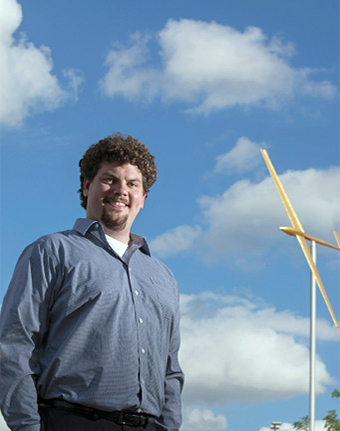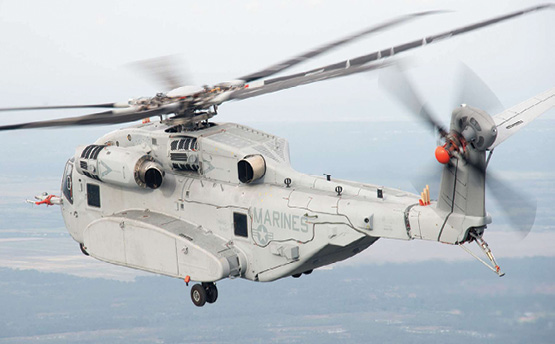Spirit AeroSystems, with its roll-outs of the composite fuselages for Sikorsky's CH-53K and Bell Helicopter's V-280 Valor, and Wichita State have many high-flying things in common. One of them is Trevor Steinbrock.

TREVOR STEINBROCK ’17 is a third-generation engineer, following the flight plan laid in by his grandfather and his dad. He is, however, the sole engineer in the Steinbrock family to play tenor sax in Shocker Sound, Wichita State’s basketball pep band.
For a little more than a year, he has worked as a design engineer at Spirit AeroSystems, one of the largest independent producers of aerostructures for commercial, military and business jets in the world. Thanks to the jumpstart he got as an intern at Spirit while pursuing his mechanical engineering degree at Wichita State, he has already been a team member on two Spirit Defense projects: the design and manufacture of composite fuselages for the CH-53K King Stallion, a heavy-lift cargo helicopter being developed for the U.S. Marine Corps by Sikorsky Aircraft, and the V-280 Valor, a tiltrotor aircraft being developed by Bell Helicopter for the U.S. Army’s Future Vertical Lift program.
“I have a special place in my heart for the V-280,” Steinbrock says. “It was my first project. I got to see what it looked like in the computer, and I got to be out on the shop floor and touch it. That’s a rare thing for an engineer to see things from start to finish – from the design phase to the build phase.”
Initially, it wasn’t an interest in planes or helicopters or even rockets that ignited his interest in engineering. The native Wichitan says he simply couldn’t help but notice how the city – and especially one of its key thoroughfares, Kellogg – was “always under construction. What drew me to engineering was watching the overall progress and process it took to get the job done. I could easily see that in construction over time.”
After high school, he set his sights on becoming a civil engineer and set off for Kansas State University, where he discovered civil engineering wasn’t exactly the right fit for him after all. Determined to continue his education in a different field of engineering, he came home to Wichita and enrolled at WSU, where his dad, R. Kevin Steinbrock ’84, had earned a bachelor’s degree in electrical engineering and went on to enjoy a career in the aircraft industry, including positions at Raytheon Aircraft and Hawker Beechcraft. Trevor’s first semester at Wichita State was in 2012. “When I first got here,” he says, “I wasn’t quite sure how I would fit in to student life. What I ended up doing was going into the music program – I actually got my music minor – and part of that was I joined the pep band and played tenor saxophone for two years.”
Those two years in Shocker Sound, whose members not only perform at men’s basketball games in Koch Arena but travel to whatever locations post-season play takes them, spanned the 2012-13 Shockers’ NCAA tournament run to the Final Four and their 2013-14 history-making undefeated regular season, before tangling with Kentucky and posting a final 35-1 record. “I loved every minute of it,” he says about his high-flying pep band playing days.
He retired his tenor sax in his third year at WSU to make more time for engineering. “You might be surprised,” he notes, “how much of the same part of the brain you use in engineering and in music.” They both, he says, have mathematical foundations. Plus, they each offer distinctive examples of what has always drawn his interest – that “progress and process” he first glimpsed in ICT’s construction projects through the years. He concentrated on his major area of study, working to gain, as he puts it, “the ability to read and understand engineering language and documents and calculations.” He also landed an internship at Spirit, an experience that refined his mechanical engineering focus to fit the aerospace field. His internship proved to be, he says, “an incredible advantage that allowed me to dive right in to becoming a full time engineer.”
While he’s the first Steinbrock engineer to work at Spirit, he’s not the first to work on the Wichita campus that serves as Spirit’s global headquarters, spanning more than 600 acres, with some 12,000 employees in 150 separate buildings. “My grandfather,” he explains, “was a successful engineer at Boeing in Wichita, where Spirit is now. In fact, I’m told that I’ve worked in the same building that he once worked in!”
On April 13, Steinbrock was back on WSU’s campus for the announcement that two of his favorite entities – Spirit and his alma mater – would build a research partnership. Via WSU’s National Institute for Aviation Research (NIAR)and the WSU Campus of Applied Sciences and Technology (WSU Tech), Spirit and Wichita State will collaborate on strategic R&D projects, applied learning opportunities for WSU students and more effective aerospace industry workforce training services.
Speaking at the news conference were a number of WSU and Spirit officials, including John Tomblin, WSU vice president for research and technology transfer, and Tom Gentile, Spirit president and CEO, who said, “We have a deep relationship with WSU, and what we’re going to talk about today is how we can expand and build upon that legacy – really build for the future.” It was Tomblin who invited Steinbrock to say a few words, too. “I said,” he reports, “that this will allow students to be part of a collaboration effort to develop that grassroots pool of skilled workers that Spirit’s going to need in the future.”
The lift one hears in his voice is evidence he still gets excited about process and progress – and finding his place in the Steinbrock, Wichita State and Spirit lineages of flight science.






